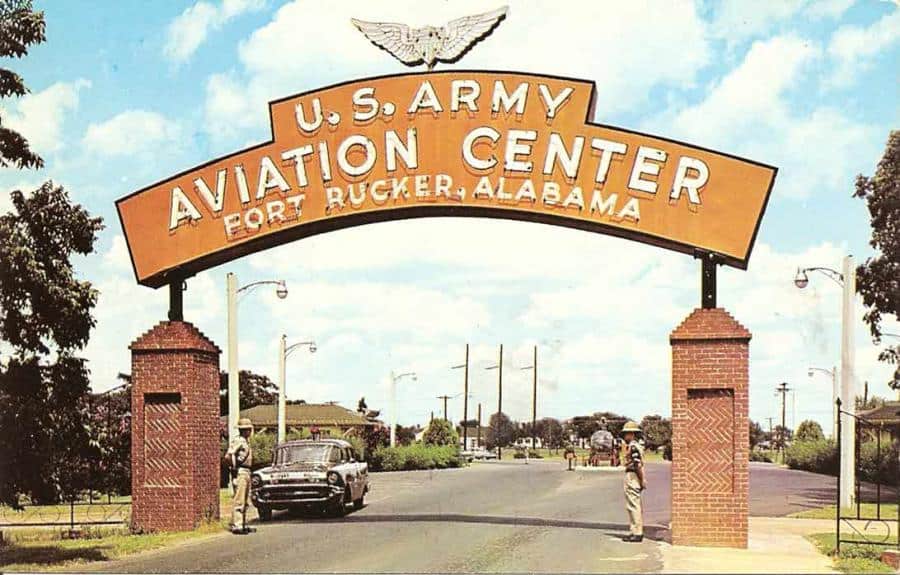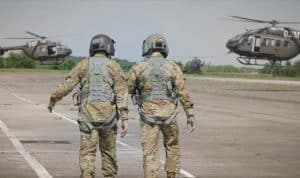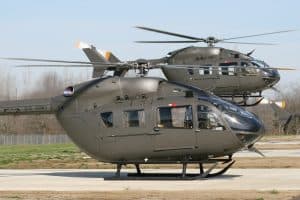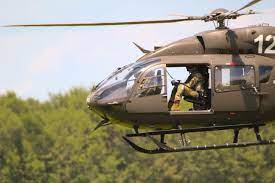Army Flight School

So you did it. You decided whether you’d be a RLO or a WO, you decided which route to take to get there, you earned a flight slot and you moved yourself (and whatever loved ones you bring with you) down to Ft. Rucker in L.A. That’s Lower Alabama, in case you confused it with some other place… And now you “Learn to Fly,” as The Foo Fighters so cordially invited you to do (feel free to take a moment and listen to that spectacular anthem, if you’d like. I’ll wait…). But make no mistake, this is not anything CLOSE to the final destination, even if it feels like it’s the culmination of years of hard work. It is, in fact, quite the opposite: it’s just the beginning.
But it’s an exciting beginning! Because this one involves the actual flying…after some more of the Officer-related training and the moderately uncomfortable experience that is SERE School. The next two weeks will be a brief overview, chronologically, of the entirety of the Flight School experience. And, given everything that entails, I want you to believe me when I say “brief.” This will be meant to give you an idea of what to expect as far as structure and timelines, but it’s hardly more than a glance into the actual meat of the different phases.
So now that your expectations have hopefully been set, welcome to Flight School.
Table of Contents
Basic Officer Leaders Course (BOLC) OR Warrant Officer Basic Course (WOBC)
This four-week course is a logical follow-on to what an Officer has already learned in the process of becoming a RLO or a WO, regardless of the route by which they accomplished that. An administrative note really quick: BOLC/WOBC is CURRENTLY four-weeks long. But that changes regularly. It’s been anywhere from 4-7 weeks. A fair portion of it is simply refreshing and re-testing skills that have been learned and tested in the process of gaining a commission: Land Navigation, Basic Tactics, Weapons Qualification…Army stuff. Soldier stuff. Officer stuff. BUT with a pinch of aviation mixed in. So RLOs and WOs will be learning a lot of the stuff you, the reader, have been learning over the course of this series of articles: the different aircraft and their mission sets, the mission of Army Aviation, as well as basic unit structure in aviation, Combat Vehicle Identification, Combined Arms doctrine (in a VERY bite-sized amount)… Like I said, the basics of officering in Army Aviation.
Most often, immediately following completion of BOLC/WOBC, students will then spend two days (though, for many, it may require a couple more) undergoing Helicopter Overwater Survival Training (HOST), more commonly known as “Dunker.” This involves a morning of academics and then a basic swim/water survival test (in uniform, so practice this if you’re a weak swimmer), the successful completion of which culminates in the actual “ditch” iterations on day two.

There are videos all over the place about this that are far more informative than trying to describe it, but in short: you strap into a box that simulates the fuselage of each Army aircraft, it gets lowered into water and flipped upside down and you have to then successfully escape and swim free without aid. And you’ll then do it all while blindfolded. Some people are incredibly intimidated by this. Don’t be…the instructors WANT you to succeed, so they’ll help you figure it out. Beyond that, it’s actually a ton of fun.
After completing Dunker, students often encounter a “bubble,” or a wait period between classes, while they’re awaiting SERE. Such bubbles can be encountered regularly throughout Flight School as students complete one training syllabus and await their next training window. These bubbles will often be filled with additional duties, details or whatever else will keep them somewhat engaged while Uncle Sam keeps paying them. The longer the bubble, the more likely that “filler-job” will be something that is 8-10 hours/day, 5 days/week. So be prepared for this.
Survive, Evade, Resist, Escape (SERE)
This is the course that is the most daunting to many, up front, when beginning the process of becoming an Aviator. Sure, people often wonder whether they’ll be any good on the controls of a helicopter – hoping they’ll just “be a natural” but worrying the opposite will be the case. Others stress about whether they’ll do well in the rigorous circuit of aviation academics. But the rumors swirling around this course are many and they are varied. Which tracks…the majority of what’s covered in the course is classified. And all of these rumors assure one that they will be uncomfortable. Often VERY uncomfortable. It’s not so much a concern for whether they’ll pass the course…it’s more a concern for how much pain they’ll need to endure BEFORE they pass the course.
And with good reason! SERE School does, indeed, get pretty uncomfortable at some points. But it’s like any uncomfortable thing; it’s uncomfortable and then it ends. So don’t sweat it. Just do the thing. And don’t give up.
 As to the nuts and bolts of the class, well…it’s not my place to divulge any of that, frankly. Like I said…it’s classified stuff. So I’ll leave it to an actual Army Public Affairs-approved message related to SERE to give you any information that’s been approved for release to the public at large. Yes, there are many places where you can get more information, but much of that is likely out-of-date, skewed by the author’s desire to make themselves seem like a Spartan at Thermopylae, or flat-out false. So if you’re interested in the basic construct and a general outline of what the course covers, follow this link.
As to the nuts and bolts of the class, well…it’s not my place to divulge any of that, frankly. Like I said…it’s classified stuff. So I’ll leave it to an actual Army Public Affairs-approved message related to SERE to give you any information that’s been approved for release to the public at large. Yes, there are many places where you can get more information, but much of that is likely out-of-date, skewed by the author’s desire to make themselves seem like a Spartan at Thermopylae, or flat-out false. So if you’re interested in the basic construct and a general outline of what the course covers, follow this link.
Be aware that various training logjams or circumstances HAVE led to students completing SERE after they’ve already completed all of their flight training. This makes absolutely no sense to me, but it happens occasionally. Don’t expect it, but just know that there’s a small possibility it could happen. I don’t know of ANYONE who would wish that on themselves or the ones they love, though, so if it happens to you…I’m very sorry.
I will say no more.
Common Core
NOW we start to fly. Almost…first it’s a few weeks of straight academic work to prepare the pilots-to-be for when they’re no longer pilots-to-be, but have emerged from their cocoons as genuine pilots. To begin, Aeromedical academics cover an IMMENSE amount of material in a relatively short amount of time. The students learn, in short, about all of the physiological and psychological phenomena that occur during all forms of flight (in open-skies, in the clouds, during the day, at night, etc.). The goal being to enable the students to be more aware of things to avoid once they’re pilots AND respond more quickly/correctly if they encounter certain symptoms while flying, e.g., hypoxia, spatial disorientation and other potentially lethal problems.
Thereafter, coursework begins to instruct students on the mechanical and digital systems they will be using when they begin flying their first aircraft, which will (now) be the LUH-72A Lakota. In addition to this, students will be assigned in pairs (“Stick-Buddies”) to Instructor Pilots (IPs), most of whom are civilian contractors: old, retired Army dudes, some of whom flew in Vietnam. Students will begin practicing engine starts in a simulator so that they have some concept of what they’re doing  when they first climb in the actual aircraft. These first four weeks of academics set the tone for what will be ongoing throughout the duration of Flight School: you fly half of the day, you go to class the other half, and you figure out when to study and do your homework somewhere in between. Academic topics cover absolutely everything: aerodynamics, weather, Visual Meteorological Conditions (VMC) flight rules, airspace, communications, FAA regulations, and on and on. A Flight School graduate will be a certified Polymath-Lite, though it’s incumbent on the individual to ensure that they maintain this gained knowledge – and, hopefully, add to it – following IERW.
when they first climb in the actual aircraft. These first four weeks of academics set the tone for what will be ongoing throughout the duration of Flight School: you fly half of the day, you go to class the other half, and you figure out when to study and do your homework somewhere in between. Academic topics cover absolutely everything: aerodynamics, weather, Visual Meteorological Conditions (VMC) flight rules, airspace, communications, FAA regulations, and on and on. A Flight School graduate will be a certified Polymath-Lite, though it’s incumbent on the individual to ensure that they maintain this gained knowledge – and, hopefully, add to it – following IERW.
Primary-
Okay, NOW we start to fly. Really this time…after a couple of days simply doing engine starts in the aircraft to make double-sure students have been paying attention before trusting them at the controls. But at long last, the day of each student’s “Nickel Ride” comes; the first day flying in the aircraft and handling the controls. Don’t put a lot of weight into how “naturally” it comes to you or what other students in the class say their IPs said to them following their brief stint on the controls. Just enjoy the ride.
The flight portion of Common Core is broken into three phases. First it’s “Primary” (hence the bolded word above). It’s usually around eight-weeks, depending on weather and other external factors. This is the intro to the very basics of learning how to fly an aircraft, mostly in a traffic pattern, and complete maneuvers related thereto. It’s not complicated flying…except that, for the majority of the class, it’s their first flying, or at least their first-flying in a rotary-wing aircraft. So it will FEEL really complicated. Every day, prior to flying, students will also have IPs keeping them honest in their study habits. They will be asking questions related to the academics, emergency procedures, aircraft limitations and anything else students have been exposed to. This is to encourage students to take their personal study seriously, but also to prepare them for the rest of their Army – and aviation – careers, as every Check Ride from Primary through Retirement will involve such quizzing.
 The first half of Primary culminates, as do all of the actual flight portions of Flight School, with just such a Check Ride to ensure a student can safely do the very basics. If successful, students then roll into their first “Solo…” which isn’t a true solo in the sense of being alone in the aircraft; your Stick Buddy will be riding along with you. And they will be praying that all of your flaws, which they’ve been mentally tallying, don’t come screaming to the fore.
The first half of Primary culminates, as do all of the actual flight portions of Flight School, with just such a Check Ride to ensure a student can safely do the very basics. If successful, students then roll into their first “Solo…” which isn’t a true solo in the sense of being alone in the aircraft; your Stick Buddy will be riding along with you. And they will be praying that all of your flaws, which they’ve been mentally tallying, don’t come screaming to the fore.
The second half of Primary is a natural progression, with more difficult (but still basic) maneuvers in both forward and hovering flight, responding to emergencies, as well as a continued focus on improving the flight skills gained during the first-half. Understand that you, and literally everyone else, will have days on which you’re nailing every maneuver and riding high, and days on which you can’t even get strapped into the aircraft right. It’s natural, it’s expected, just keep working hard and keep going. Don’t get discouraged. The second Primary Check Ride (P2 Check Ride) is the final event of Primary, spring-boarding students into:
Instruments-
This phase of IERW begins in simulators. The phase itself is another eight-ish weeks. In the Lakota, simulator time is SIGNIFICANTLY reduced from what it was just four or five years ago in the TH-67 Creek. This is due, simply, to the LUH-72 being a fantastic Instruments platform. So simulators will only be 2-3 weeks.
The entirety of the Instruments phase is dedicated to teaching Army pilots how to fly in the clouds, when they can’t see, and still get where they need to go. It prepares Army pilots, upon completion, to be able to certify as Commercial-Instrument pilots, as they will gain the skills and knowledge necessary to maneuver in FAA Airspace. Foci include Instrument Flight Rules (IFR) flight planning, proper holding procedures, reporting in accordance with FAA regulations, using Army and FAA publications, and so on. Naturally, the ongoing Academics, which still consume half of the students’ day, will mirror and add to this capability.
This phase is incredibly strenuous for some. It’s very cerebral, as students have to be able to consume a LOT of information and remember it well enough to be able to practically apply it as well as retain the knowledge gained during the prior portions of both Flight and Academics. Everything to which students have been exposed is, and will forever be, fair game for knowledge checks/quizzes/examinations. Some individuals who absolutely thrived during Primary may stumble pretty severely during Instruments. It’s the nature of the animal and certainly tests people’s will and perseverance.
and remember it well enough to be able to practically apply it as well as retain the knowledge gained during the prior portions of both Flight and Academics. Everything to which students have been exposed is, and will forever be, fair game for knowledge checks/quizzes/examinations. Some individuals who absolutely thrived during Primary may stumble pretty severely during Instruments. It’s the nature of the animal and certainly tests people’s will and perseverance.
But as always…just work hard and don’t give up. And you’ll be fine. Students will, naturally, be required to pass a Check Ride to get out of the simulator and into the aircraft, and pass another at the end of the eight-weeks to complete the Instruments phase.
Basic Warfighter Skills (BWS)-
This phase has gone by many names, but regardless what it’s called it is, easily, the most fun flying one does during all of Common Core. It’s where flight students learn how to fly and operate like Army pilots. The phase is only 4-6 weeks (the last 2-3 of which are free of academics!) and introduce flying with Night Vision Goggles (NVGs). These weeks are focused on introducing the different types of terrain flight. So students will learn to fly, and spend the entire phase flying, anywhere from 50’ above the trees to 200’ above the trees.
They’ll also learn to navigate using a map, compass and terrain association, in the event that all aircraft navigation systems  were ever to take a crap and there was no other option. Students will be on aerial treasure hunts, essentially, as they will be given grids to plot on a map and they will need to navigate to those grids and find the specific Landing Zone (LZ) associated therewith. As I said…it’s a fun phase.
were ever to take a crap and there was no other option. Students will be on aerial treasure hunts, essentially, as they will be given grids to plot on a map and they will need to navigate to those grids and find the specific Landing Zone (LZ) associated therewith. As I said…it’s a fun phase.
There will, additionally, be a focus on learning to land on slopes, learning to operate in confined areas (i.e. postage stamps of grass in the middle of a forest), and other such skills that are involved with actual Army Aviation operations. One such skill, as stated above, is NVG flight. It’s a profile that takes some getting used to, ESPECIALLY considering the altitudes and the maneuvers that are the focus of this phase. But it doesn’t take long for students to become reasonably comfortable operating “under Goggles.” There will be a specific portion of academics dedicated to NVGs to teach students about how to use them to the greatest effect in conducting night-flight operations.
Conclusion
And suddenly you’re done! Two BWS Check Rides, some more academic exams, an Army Physical Fitness Test (APFT, soon to be the new ACFT)…and you’re Common Core complete! I CANNOT STRESS ENOUGH HERE how important it is to make sure you are regularly exercising throughout all of Common Core. Too often, individuals have completed the entirety of Common Core, failed their APFT and been kicked out of Flight School. They did ALL of that work and experienced ALL of that stress for YEARS to try and become a pilot…and it’s gone. The Army will find another home for them…based off of the needs of the Army.
…but for everyone else, only 20-ish weeks after starting, Common Core is over. Now each individual student’s performance in Academics, Check Rides, BOLC/WOBC, APFTs, etc., throughout every phase completed to this point will be taken into account as an Order of Merit List (OML, or class placement) is created. And then selection day comes. For Guardsmen and Reservists, this is a very low-stress day; they already know what aircraft they’ll be flying. For the Active Duty officers, on the other hand, this day can be a source of immense stress. You will select your aircraft based off of your class placement. So if you’re not in the top 30-40%, there’s a good chance you will not be choosing your aircraft, the Army will be choosing it for you.
If your heart is absolutely set on one aircraft, there’s a chance you’ll be disappointed even if you’re the class’s top performer, unfortunately, and this is…wait for it…based off of the needs of the Army (get used to that phrase). This NEVER happens with Chinooks, but there have been entire classes who have been relegated to Apaches or ‘Hawks because the Army had a dire need. This is an exception, however, not a rule. So although I’ve stated it a dozen times over the weeks, it’s worth saying again: work hard. Do your best to be your best. Only then will you be giving yourself your best shot at controlling your fate.
Next week, I’ll do a follow-up article to cover the last portions of Flight School: training in your “Go-to-War” aircraft, WOBC/BOLC-B and potential extracurriculars. Until then…
Cheers!







